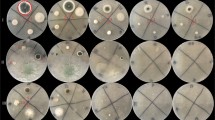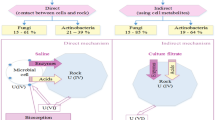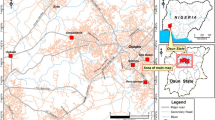Abstract
Purpose
The present study was aimed to evaluate the fungal resistance level toward lanthanum as well as the influence of La on the development of fungi isolates also, assessing their biosorption and bioaccumulation capacity.
Material and Methods
Spray technique of lanthanum was used for fungi growth, then testing each fungi tolerance index and biosorption capacity for lanthanum.
Results
Only one fungi strain from three could tolerate until 3500 ppm La which undergoes a morphological, gene sequencing and phylogenetic analysis to be a strain MK457457.1 of Aspergillus niger. Aspergillus showed a high biosorption capacity in the synthetic concentrations with a removal percent of 99.89 and 84.70 at 200 and 3500 ppm respectively, this result was confirmed by scan electronic microscope (SEN) and energy dispersive X-ray (EDX) analysis. On testing Aspergillus on concentrated rare earth sample derivative from monazite from nuclear materials authority, Aspergillus showed a high removal percent even in the presence of many metals’ competition and interference, the removal percent activity of Aspergillus niger showed a high affinity in the REEs concentrated monazite sample for La, Ce, Nd and Dy recording 77.26, 64.29, 59.87 and 94.42 respectively.
Discussion
Fungi has a strong ability to adapt with the environmental stress as metal pollution with an improvement to mineral bioleaching, this may be due to the cell wall composition which includes 80–90% polysaccharides, proteins, lipids, polyphosphates, inorganic ions and other biosorption agents, accompanied with the extracellular biodegradative enzymes secretion and the siderophores or polymers, all this factor produce an excellent metal-binding and bioleaching-biosorption properties.
Conclusion
Fungi were considered as a promising microorganism that helps in a great form in bioremediation and cleaning the environment and soil and from many metals to be able for its reuse.






Similar content being viewed by others
References
Zglobicki W (2022) Special issue on heavy metals in the environment—causes and consequences. Appl Sci 12(2):835
Abdel-Rahman MO, Rezk MM, Abdel Moneim AE, Ahmed-Farid OA, Safia S (2019) Thorium exerts hazardous effects on some neurotransmitters and thyroid hormones in adult male rats. Naunyn Schmiedebergs Arch Pharmacol 393(2):167–176
Rezk MM, Dhmees AS, Abd El-Magied MO, Manaa EA, El-Gendy HS (2020) The influence of cobalt manganese ferrite nanoparticles (Co0.5Mn0.5Fe2O4) on reduction of hazardous effects of vanadate in adult rats. Toxicol Res 9(2):1–10
Abo El-Ezz A, Abdel-Rahman MO, Mohamed AS, Sayed RA, Rezk MM (2010) Toxicological and Physiological studies on the effects of Zinc on Oreochromis niloticus. J Egypt Acad Soc Environ Dev 11(1):61–72
Abdel-Rahman MO, Bauomi AA, Abdel Kader SM, Mohammaden TF, Rezk MM (2015) Effect of cardamom (Elletaria cardamomum) on brain ions and acetylcholine esterase enzyme of albino rats ingested uranium. Int J Basic Life Sci 3(3):122–138
Abdel-Rahman M, Rezk MM, Abdel Kader SM (2017) The role of cardamom on the hazardous effects of depleted uranium in cerebellum and midbrain of albino rats. Toxicol Environ Health Sci 9(1):64–73
Abdel Kader SM, Bauomi AA, Abdel-Rahman M, Mohammaden TF, Rezk MM (2015) Antioxidant potentials of (Elletaria cardamomum) cardamom against uranium hazards. Int J Basic Life Sci 3(4):164–181
Healy R, Whelan N, Kenny IC, Harrison AJ (2015) The assessment of stride frequency in running using a single accelerometer. In: 4th international conference on ambulatory monitoring of physical activity and movement (ICAMPAM), Limerick, Ireland
Park DM, Reed DW, Yung MC, Eslamimanesh A, Lencka MM, Anderko A, Fujita Y, Riman RE, Navrotsky A, Jiao Y (2016) Bioadsorption of rare earth elements through cell surface display of lanthanide binding tags. Environ Sci Technol 50:2735–2742
Ismail Z, Abu Elgoud E, Gasser M, Aly H, Abdel Hai F, Ali I (2015) Leaching of some lanthanides from phosphogypsum fertilizers by mineral acids. Arab J Nucl Sci Appl 48:37–50
Perea C, Restrepo O (2018) Use of amino acids for gold dissolution. Hydrometallurgy 177:79–85
Carrillo-Gonzalez R, Gonzalez-Chavez MC (2012) Tolerance to and accumulation of cadmium by the mycelium of the fungi Scleroderma citrinum and Pisolithus tinctorius. Biol Trace Elem Res 146:388–395
Fang L, Wu B, Chan JKM, Lo IMC (2018) Lanthanum oxide nanorods for enhanced phosphate removal from sewage: a response surface methodology study. Chemosphere 192:209–216
Oladipo OG, Olayinka A, Awotoye OO (2016) Maize (Zea mays L.) performance in organically remediated mine site soils. J Environ Manag 182:435–442
de la Cueva SC, Rodríguez CH, Cruz NOS, Contreras JAR, Miranda JL (2016) Changes in bacterial populations during bioremediation of soil contaminated with petroleum hydrocarbons. Water Air Soil Pollut 227(3):1–12
Ghoniemy EA, Mohammeden TF, El-Shahat MR, Elkhawaga MA, Rezk MM, Morsi W (2020) Fungal treatment for liquid waste containing U(VI) and Th(IV). Biotechnol Rep 26:1–13
Morsi WM, Ghoniemy EA, Mohammeden TF, El-Shahat MR, Elkhawaga MA, Rezk MM (2020) Bio-removal of chromium ions from chemical laboratories wastewater. Curr Sci Int 9(2):295–311
Gadd GM (1999) Fungal production of citric and oxalic acid: importance in metal speciation, physiology and biogeochemical processes. Adv Microb Physiol 41:47
Tomova I, Stoilova-Disheva M, Lazarkevich I, Vasileva-Tonkova E (2015) Antimicrobial activity and resistance to heavy metals and antibiotics of heterotrophic bacteria isolated from sediment and soil samples collected from two Antarctic islands. Front Life Sci 8(4):348–357
Kang CH, Kwun YJ, So JS (2016) Bioremediation of heavy metals by using bacterial mixtures. Ecol Eng 89:64–69
Augustyniak A, Cendrowski K, Nawrotek P, Barylak M, Mijowska E (2016) Investigating the interaction between Streptomyces sp. and titania/silica nanospheres. Water Air Soil Pollut 227(7):230
Desouky OA, El-Mougith AA, Hassanien WA, Awadalla GS, Hussien SS (2016) Extraction of some strategic elements from thorium-uranium concentrate using bioproducts of Aspergillus ficuum and Pseudomonas aeruginosa. Arab J Chem 9:S795–S805
Keekan KK, JalondharaAbhilash JC (2017) Extraction of Ce and Th from monazite using REE tolerant Aspergillus niger. Min Proc Extr Metall Rev 38:312–320
Iskandar NL, Zainudin NAIM, Tan SG (2011) Tolerance and biosorption of copper (Cu) and lead (Pb) by filamentous fungi isolated from a freshwater ecosystem. J Environ Sci 23:824–830
Puglisi I, Faedda R, Sanzaro V, Piero ARL, Petrone G, Cacciola SO (2012) Identification of differentially expressed genes in response to mercury I and II stress in Trichoderma harzianum. Gene 506:325–330
Elwan SH, El-Naggar MR (1972) The growth behavior of Azotobacter chroococcum in association with some microorganisms in the soil. J Basic Microbiol 12(1):7–13
Kumar A, Bisht BS, Joshi VD (2011) Bioremediation potential of three acclimated bacteria with reference to heavy metal removal from waste. Int J Environ Sci 2:896–908
Xu X, Xia L, Huang Q, Gu J-D, Chen W (2012) Biosorption of cadmium by a metal-resistant filamentous fungus isolated from chicken manure compost. Environ Technol 33:1661–1670
Ivanov VM, Ermakova NV (2001) Optical and chromaticity characteristics of Arsenazo III complexes of rare-earth elements. J Anal Chem 56:519–523
Barnett HL, Hunter BB (1999) Illustrated genera of imperfect fungi, 4th edn. Prentice Hall Inc
Zafar S, Aqil F, Ahmad I (2006) Metal tolerance and biosorption potential of filamentous fungi isolated from metal contaminated agricultural soil. Bioresour Technol 98:2557–2561
Altschul SF, Madden TL, Schaffer AA, Zhang JH, Zhang Z, Miller W, Lipman DJ (1997) Gapped BLAST and PSI-BLAST: a new generation of protein database search programs. Nucleic Acids Res 25:3389–3402
FAO “Food Administration Organization’ (1992) Committee for Inland Fisheries of Africa. Report of the third session of the working party on pollution and Fisheries. Accra, Ghana, pp 25–29
Asghari I, Mousavi SM, Amiri F, Tavassoli S (2013) Bioleaching of spent refinery catalysts: a review. J Ind Eng Chem 19:1069–1081
Mulligan CN, Kamali M, Gibbs BF (2004) Bioleaching of heavy metals from a low-grade mining ore using Aspergillus niger. J Hazard Mater 110:77–84
Lemire J, Harrison JJ, Turner RJ (2013) Antimicrobial activity of metals: mechanisms, molecular targets and applications. Nat Rev Microbiol 11(6):371–384
Dixit R, Wasiullah MD, Pandiyan K, Singh UB, Sahu A, Shukla R, Singh BP, Rai JP, Sharma PK, Lade H, Paul D (2015) Bioremediation of heavy metals from soil and aquatic environment: an overview of principles and criteria of fundamental processes. Sustainability 7(2):2189–2212
Mishra A, Malik A (2012) Simultaneous bioaccumulation of multiple metals from electroplating effluent using Aspergillus lentulus. Water Res 46:4991–4998
Iram S, Ahmad I, Javed B, Yaqoob S, Akhtar K, Kazmi MR et al (2009) Fungal tolerance to heavy metals. Pak J Bot 41:2583–2594
White PR, Franke M, Hindle P (1995) Integrated solid waste management: a lifecycle inventory. Springer, Berlin
Tsekova DS, Williams DR, Heng JYY (2012) Effect of surface chemistry of novel templates on crystallization of proteins. Chem Eng Sci 77:201–206
Price MS, Classen JJ, Payne GA (2001) Aspergillus niger absorbs copper and zinc from swine wastewater. Bioresour Technol 77:41–49
Dusengemungu L, Kasali G, Gwanama C, Mubemba N (2021) Overview of fungal bioleaching of metals. Environ Adv 5:100083
Author information
Authors and Affiliations
Corresponding author
Ethics declarations
Conflict of interest
Mohamed M. Rezk and Wessam M. Morse declare that they have no conflict of interest.
Ethical approval
The investigation protocol was approved by the ethics committee of nuclear material authority, which is performed following the ethical standards laid down in the US guidelines (NIH Publication No. 85-23, amended in 1985).
Rights and permissions
Springer Nature or its licensor (e.g. a society or other partner) holds exclusive rights to this article under a publishing agreement with the author(s) or other rightsholder(s); author self-archiving of the accepted manuscript version of this article is solely governed by the terms of such publishing agreement and applicable law.
About this article
Cite this article
Rezk, M.M., Morse, W.M. The highly tolerant fungi and extraction potentiality of lanthanum: application on rare earth elements concentrate derivative from monazite. Toxicol. Environ. Health Sci. 15, 31–39 (2023). https://doi.org/10.1007/s13530-022-00155-4
Accepted:
Published:
Issue Date:
DOI: https://doi.org/10.1007/s13530-022-00155-4




